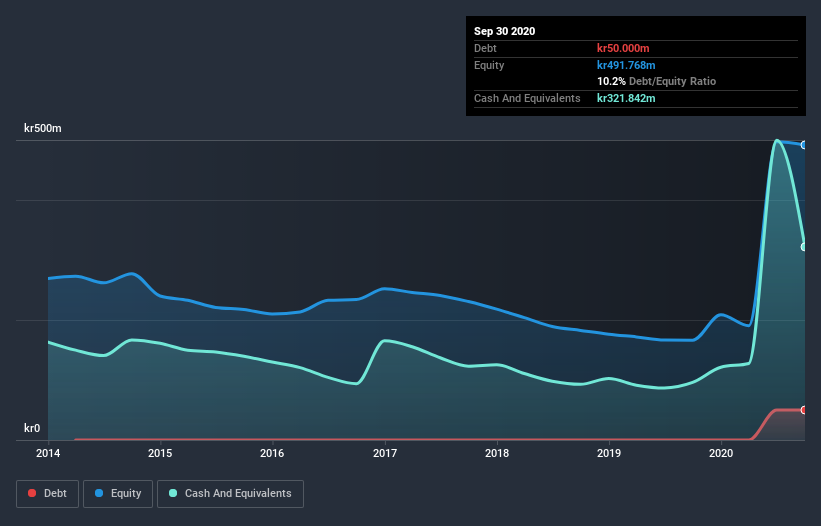Stock Analysis

Warren Buffett famously said, 'Volatility is far from synonymous with risk.' It's only natural to consider a company's balance sheet when you examine how risky it is, since debt is often involved when a business collapses. Importantly, Photocure ASA (OB:PHO) does carry debt. But the real question is whether this debt is making the company risky.
When Is Debt Dangerous?
Debt is a tool to help businesses grow, but if a business is incapable of paying off its lenders, then it exists at their mercy. Ultimately, if the company can't fulfill its legal obligations to repay debt, shareholders could walk away with nothing. However, a more usual (but still expensive) situation is where a company must dilute shareholders at a cheap share price simply to get debt under control. Having said that, the most common situation is where a company manages its debt reasonably well - and to its own advantage. When we think about a company's use of debt, we first look at cash and debt together.
See our latest analysis for Photocure
How Much Debt Does Photocure Carry?
You can click the graphic below for the historical numbers, but it shows that as of September 2020 Photocure had kr50.0m of debt, an increase on none, over one year. But it also has kr321.8m in cash to offset that, meaning it has kr271.8m net cash.

How Healthy Is Photocure's Balance Sheet?
We can see from the most recent balance sheet that Photocure had liabilities of kr58.7m falling due within a year, and liabilities of kr58.0m due beyond that. On the other hand, it had cash of kr321.8m and kr32.2m worth of receivables due within a year. So it can boast kr237.5m more liquid assets than total liabilities.
This short term liquidity is a sign that Photocure could probably pay off its debt with ease, as its balance sheet is far from stretched. Simply put, the fact that Photocure has more cash than debt is arguably a good indication that it can manage its debt safely.
It was also good to see that despite losing money on the EBIT line last year, Photocure turned things around in the last 12 months, delivering and EBIT of kr20m. When analysing debt levels, the balance sheet is the obvious place to start. But it is future earnings, more than anything, that will determine Photocure's ability to maintain a healthy balance sheet going forward. So if you want to see what the professionals think, you might find this free report on analyst profit forecasts to be interesting.
Finally, while the tax-man may adore accounting profits, lenders only accept cold hard cash. While Photocure has net cash on its balance sheet, it's still worth taking a look at its ability to convert earnings before interest and tax (EBIT) to free cash flow, to help us understand how quickly it is building (or eroding) that cash balance. During the last year, Photocure burned a lot of cash. While investors are no doubt expecting a reversal of that situation in due course, it clearly does mean its use of debt is more risky.
Summing up
While we empathize with investors who find debt concerning, you should keep in mind that Photocure has net cash of kr271.8m, as well as more liquid assets than liabilities. So we don't have any problem with Photocure's use of debt. The balance sheet is clearly the area to focus on when you are analysing debt. But ultimately, every company can contain risks that exist outside of the balance sheet. Consider for instance, the ever-present spectre of investment risk. We've identified 2 warning signs with Photocure (at least 1 which is concerning) , and understanding them should be part of your investment process.
If you're interested in investing in businesses that can grow profits without the burden of debt, then check out this free list of growing businesses that have net cash on the balance sheet.
If you decide to trade Photocure, use the lowest-cost* platform that is rated #1 Overall by Barron’s, Interactive Brokers. Trade stocks, options, futures, forex, bonds and funds on 135 markets, all from a single integrated account. Promoted
New: Manage All Your Stock Portfolios in One Place
We've created the ultimate portfolio companion for stock investors, and it's free.
• Connect an unlimited number of Portfolios and see your total in one currency
• Be alerted to new Warning Signs or Risks via email or mobile
• Track the Fair Value of your stocks
This article by Simply Wall St is general in nature. It does not constitute a recommendation to buy or sell any stock, and does not take account of your objectives, or your financial situation. We aim to bring you long-term focused analysis driven by fundamental data. Note that our analysis may not factor in the latest price-sensitive company announcements or qualitative material. Simply Wall St has no position in any stocks mentioned.
*Interactive Brokers Rated Lowest Cost Broker by StockBrokers.com Annual Online Review 2020
Have feedback on this article? Concerned about the content? Get in touch with us directly. Alternatively, email editorial-team@simplywallst.com.
About OB:PHO
Photocure
Engages in the research, development, production, distribution, marketing, and sale of pharmaceutical products in Nordic countries, Germany, France, Austria, the United Kingdom, the BeNeLux, Italy, other European Countries, Canada, and the United States.
Flawless balance sheet and undervalued.

